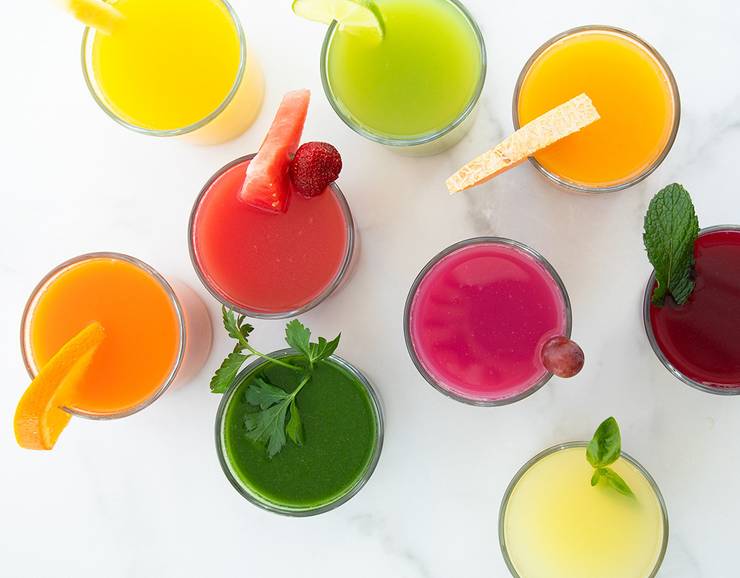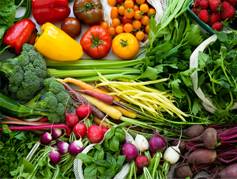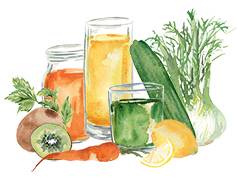Articles
Juice the Rainbow
One of the first things you might notice when you start making your own juice is all the vibrant colors. You have probably enjoyed green juice, red juice, or sometimes if you mix too many colors together you get brown juice. It might look a little strange, but it still tastes good!
What you might not realize is that each color has specific nutrients and vitamins that can help you achieve and maintain better health. In fact, one of the best ways to get all of the vitamins, minerals, and nutrients you need is to eat a variety of colorful fruits and veggies. Adding more color to your plate and drinking glass is a great way to add a variety of phytochemicals and phytonutrients to your diet, which are helpful substances produced by plants.
People who eat foods rich in these nutrients have lower rates of chronic health conditions like heart disease and cancer.[1] They can also help fight inflammation.
Dr. Andrew Weil, a world renowned leader in Integrative Medicine, was one of the first people to discuss inflammation and the role it plays in disease.
“Following an anti-inflammatory diet can help counteract the chronic inflammation that is a root cause of many serious diseases, including those that become more frequent as people age,” he writes on his website.[2]
Not surprisingly, at the base of Dr. Weil’s anti-inflammatory diet and food pyramid are vegetables and fruit. He recommends a minimum of 4 to 5 servings per day of vegetables (one serving is equal to 2 cups salad greens or ½ cup vegetables cooked, raw, or juiced) and 3 to 4 servings of fruit per day (one serving is equal to 1 medium-size piece of fruit, ½ cup chopped fruit, ½ cup dried fruit).
That’s because both fruits and vegetables are rich in flavonoids and carotenoids that contain antioxidants and anti-inflammatory properties.
He recommends eating a wide range of colors, both raw and cooked, and choosing organic when possible. And while diet has a huge impact on overall health, Dr. Weil also suggests maintaining physical activity throughout life, getting good rest and sleep, working to reduce stress, and maintain fulfilling relationships.

Variety Is the Spice of Life
Another important point is to eat colors as often as possible.” In Frances Largeman-Roth’s book Eating in Color, the RDN, she writes, “Antioxidants don’t stay in our bodies very long, and we are constantly being barraged by damaging free radicals…." So it’s smart to pack some color into your daily diet, preferably with each meal.
As the saying goes, variety is the spice of life, and this certainly matters when it comes to consuming a rainbow of colors each day. Vegetables and fruits are an important part of a healthy diet, and research now finds that variety is as important as quantity.[3] So while it might be tempting to make the same green juice each day (or whatever color you prefer), remember that no single fruit or veg can provide all that you need. It’s all about mixing up the colors so your body can receive all the nutrients it needs.
Let’s talk specifics. Learn more about the colors of the rainbow and how each color can help nourish you.

Red Produce
Grapes, beets, tomatoes, watermelon, red peppers, cherries, strawberries, raspberries, pomegranates, cranberries, and more.
Consuming red fruits and vegetables can help you maintain a healthy heart, urinary tract, maintain memory, and more, according to Michigan State University Extension.[4] Red produce is an abundant source of lycopene, which is an antioxidant known to help protect the body from free radical stress that can damage DNA. Recent evidence-based research shows that lycopene can help maintain bone strength.[5]
Red fruits and vegetables also provide resveratrol, a plant compound that can help reduce blood clotting, decrease pain and swelling, and help the body fight disease.

Orange Produce
Carrots, pumpkin, squash, sweet potato, oranges, mangoes, apricots, nectarines, persimmons, peaches, cantaloupes, papaya, turmeric, and more.
Orange-colored produce has a large concentration of carotenoids, which are a type of plant pigment that produces that bright color and acts as an antioxidant in the body. Both beta-carotene and lycopene are part of this category of carotenoids. Beta-carotene works to convert vitamin A in the body, which is helpful for healthy skin along with building a strong immune system.
“While beta-carotene is the shining star of the orange family, there are definitely other important nutrients in orange-fleshed fruits and vegetables,” Largeman-Roth, RDN, told Clean Plates.
Other essential nutrients found in orange produce are potassium and vitamin C.[6]

Green Produce
Arugula, broccoli, kale, spinach, chard, lettuce, collards, dandelion, Bok choy, cabbage, cucumber, celery, Brussel sprouts, kiwi, apple, limes, pears, asparagus, snow peas, green beans, zucchini, and more.
Greens are an important part of any diet, and in particular, dark leafy greens supply many important minerals such as calcium, magnesium, and iron, along with vitamin K, folic acid, and fiber. When the Centers for Disease Control and Prevention studied nutrient density for almost 50 fruits and vegetables, 17 of the top 20 were leafy greens.[7] A 2018 study discovered that just one daily serving of leafy greens may help slow cognitive decline.[8]
Their color comes in large part from chlorophyll, the green pigment that helps plants absorb the energy needed to grow and build tissues.[9]
Research shows that consuming more greens is linked to many health benefits including a reduced risk of heart disease, certain cancers, macular degeneration, and type 2 diabetes.

Yellow Produce
Pineapple, golden beets, yellow peppers, golden kiwi fruit, grapefruit, bananas, lemons, star fruit, summer squash, spaghetti squash, quince, and more.
Fruits and vegetables that are sunnier in color, a.k.a. yellow, come packed with an array of antioxidants, vitamins and other health-supportive components. While many in this color category contain carotenoids, bioflavonoids, and vitamin C, individual foods also contain special nutrients.
For example, pineapples contain bromelain, which is an enzyme mixture known to help enhance digestion, fight inflammation, and relieve sinus issues.[10] Lemons have limonoids, a type of phytonutrient that exhibits anticancer, antibacterial, antifungal, antimalarial, and antiviral properties.[11]

Purple Produce
Grapes, blueberries, purple carrots, radicchio, eggplant, red cabbage, red onion, shallots, plums, radish, olives, and more.
When you see purple foods, you can think of anthocyanins, a type of antioxidant in the flavonoid family found in them. Research shows this plant power can help reduce inflammation and protect you from health issues like cancer, Alzheimer’s disease, heart disease, and type 2 diabetes.[12]
One way to maximize your intake of anthocyanins is to eat them raw, juiced, and when they are most ripe.

White Produce
Cauliflower, leeks, garlic, onions, parsnips, turnips, mushrooms, potato, fennel, and more.
Technically, white is not a color in the rainbow, but white fruits and vegetables are important to include in the diet, too. These white foods contain nutrients like allicin, quercetin, sulforaphane, and potassium.
For example both garlic and onions contain allicin, which is an organic compound with antibacterial properties that has been studied for everything from cardiovascular health to immunity.[13]
Our Favorite Produce Available in August
Here’s a guide to some of the best seasonal fruits and veggies this month. Remember: seasonal foods will be a little different depending on where you live, soil conditions, and weather.
BEST VEGETABLES IN SEASON
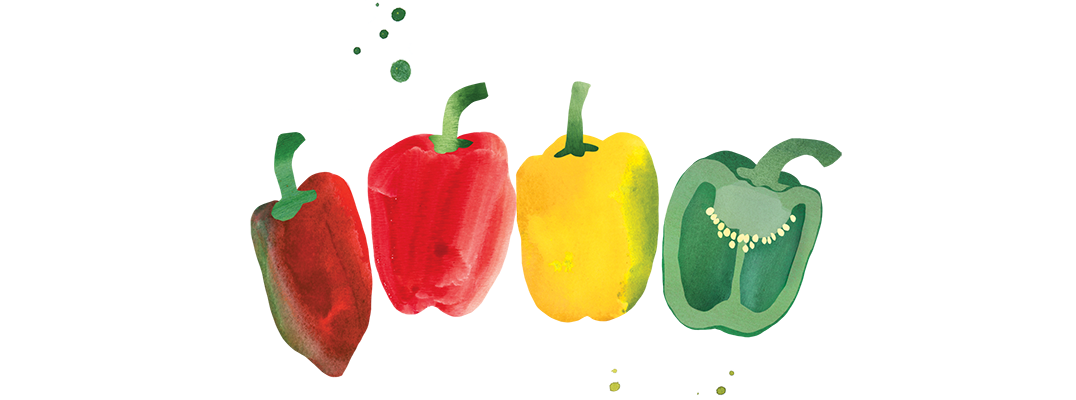
BELL PEPPERS
Peppers are considered fruit in the botanical world, because they grow from a blossom. However, we generally think of them as vegetables for cooking and eating. Unlike other types of peppers, they are typically sweet and mild rather than spicy. These crunchy veggies are rich in vitamin C.[14]
• Shopping Tip: Look for peppers with smooth and shiny skin that feel firm, which is a sign they are ripe and ready to eat.
• Varieties: See colors like green, yellow, red, orange, and purple. Red peppers are the sweetest and green peppers can be stored the longest.
• Storage Tip: You can keep bell peppers on the countertop if you plan to use them within a day or two. Otherwise, dry peppers and store them in a produce bag in the crisper drawer.
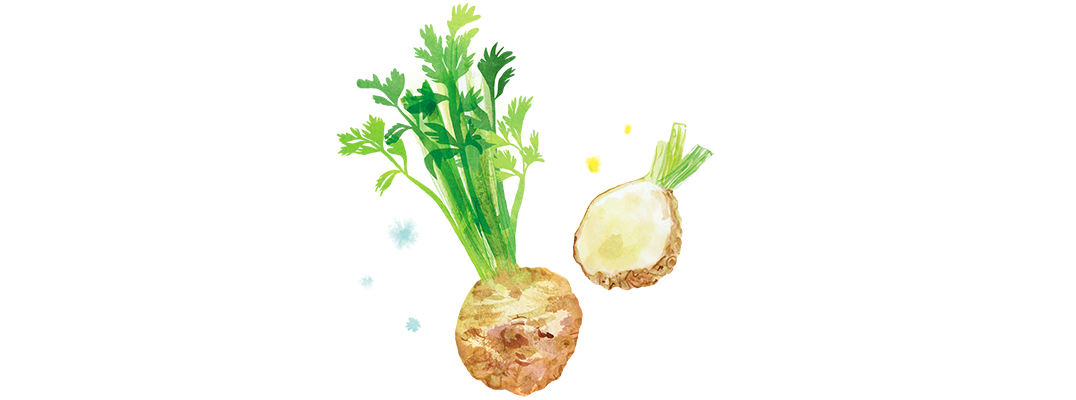
CELERY ROOT
Celery root, also known as celeriac or knob celery, is a more unknown root that thrives this time of year. Originally from the Mediterranean, this funny looking vegetable resembles an overgrown, contorted turnip with white flesh. Like a turnip or radish, it can be eaten raw or cooked and has a similar taste to celery.
• Shopping Tip: Look for a smooth surface without any cracks or discoloration.
• Storage Tip: Store celery root in the vegetable crisper of your fridge.
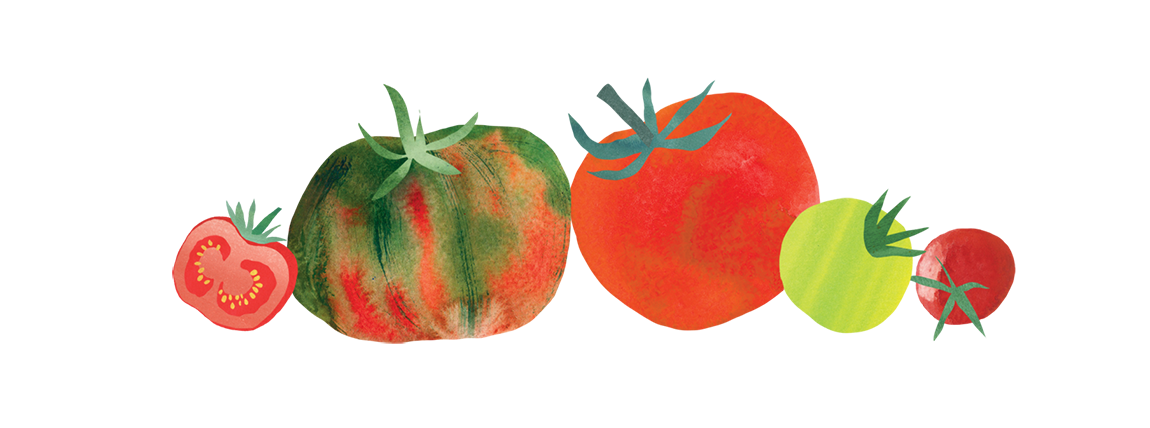
TOMATO
August is a great time to enjoy fresh, ripe tomatoes off the vine. Tomatoes are not always red; they can be yellow, pink, purple, black, and even white with more than 10,000 varieties found worldwide. They are a wonderful source of vitamins A and C.[15]
• Shopping Tip: Look for a vibrant color that smells sweet and feels firm but not too hard.
• Storage Tip: Refrigerating tomatoes causes them to lose flavor, so keep them on the counter and don’t stack them. Find a wide bowl and let them sit next to one another.
BEST FRUITS IN SEASON
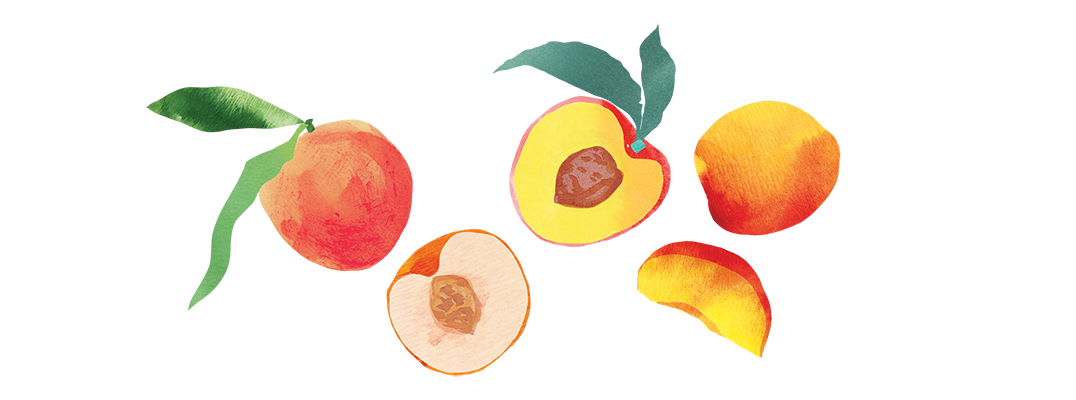
PEACHES
Summer is synonymous with peaches. They are sweet, juicy, and hydrating but also nutritious with vitamins A, C, and potassium.[16] They go great in a juice with greens to add a little sweetness.
• Shopping Tip: Always go with the aroma and pick peaches that smell sweet. If you happen to bring home a more firm peach, let it ripen on the counter for a few days.
• Storage Tip: Once your peaches are ripe, you can store them in the fridge to extend their life. Slicing and freezing them is a great way to enjoy them past their prime.
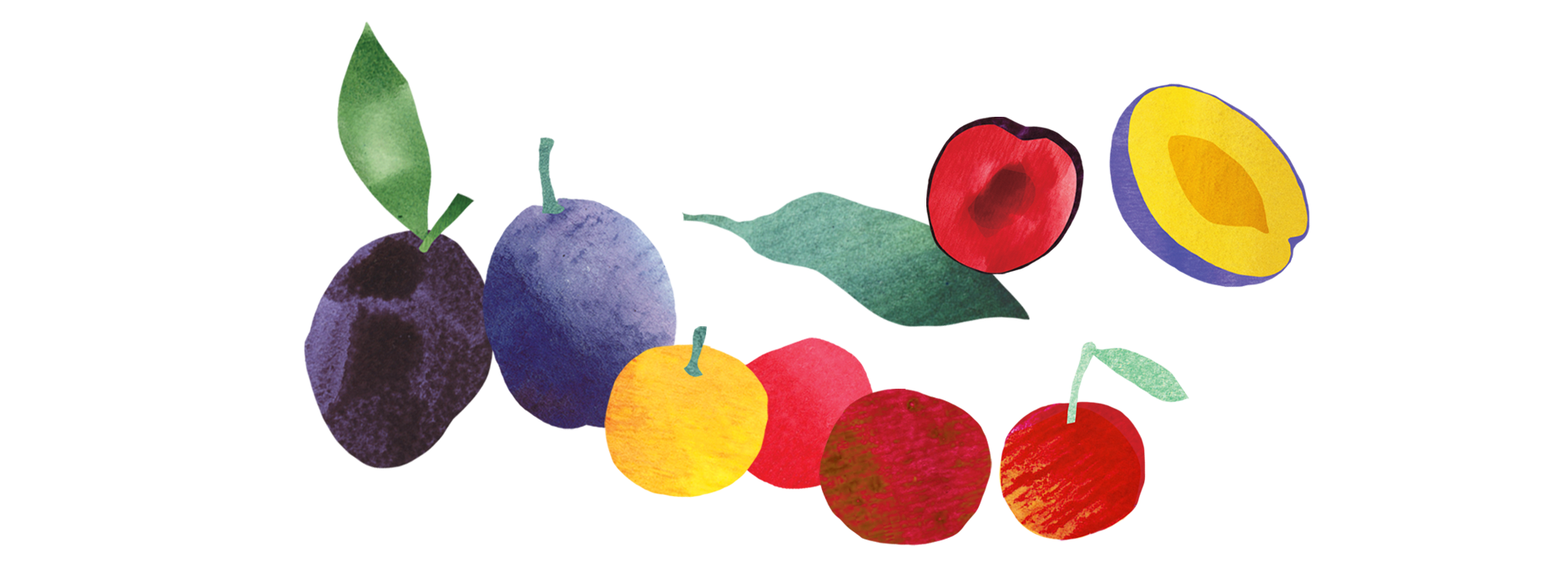
PLUMS
In the 18th century, the word “plum” was used to signify something desirable, as in dessert. Today, plums make a great summertime dessert or anytime snack. They have less sugar than other fruits while still containing many essential vitamins and antioxidants.[17]
• Shopping Tip: A ripe plum will have just a little bit of give when you squeeze it.
• Storage Tip: If you happen to bring home hard plums, leave them on the counter for a few days in a paper bag and they will ripen up. Once ripe, store in the fridge for 3-5 days.

Juicing Tips
from Jessica Forte
& Salvador Andreu
1. What are your top three in-season ingredients you love to juice from your garden?
Our top three in-season ingredients we love to juice from our garden are turmeric, passion fruit, and pineapple. Turmeric and pineapple are both anti-inflammatory and rich in essential nutrients. Passion fruit has a delicious tropical and tangy flavor that pairs perfectly with ginger and makes a mouthwatering juice!
2. What is your favorite juicing tip?
Opt for local and organic fruits and veggies when possible! Studies show that local and organic produce yield higher nutritional value than imported conventional produce. Plus, you don’t have to worry about any toxic pesticides and chemicals in your healthy juice.
Inspiring Nonprofit to Know About
Each month, we celebrate an inspiring nonprofit that makes fruits and vegetables more accessible to everyone.
Produce for Better Health Foundation
Produce for Better Health Foundation (PBH) is the only national 501(c)3 non-profit organization whose mission is to achieve increased daily consumption of fruits and vegetables for better health. They work to accomplish this mission by leveraging private industry and public sector resources, motivating key consumer influencers and creating demand for fruits and vegetables through direct engagement with consumers.
sources:
1. https://www.health.harvard.edu/staying-healthy/add-color-to-your-diet-for-good-nutrition
2. https://www.drweil.com/diet-nutrition/anti-inflammatory-diet-pyramid/what-is-dr-weils-anti-inflammatory-food-pyramid
3. https://www.hsph.harvard.edu/nutritionsource/what-should-you-eat/vegetables-and-fruits
4. https://www.canr.msu.edu/news/benefits_of_red_produce
5. https://translational-medicine.biomedcentral.com/articles/10.1186/s12967-020-02238-7
6. https://www.health.harvard.edu/staying-healthy/add-color-to-your-diet-for-good-nutrition
7. https://www.cdc.gov/pcd/issues/2014/13_0390.htm
8. https://www.ncbi.nlm.nih.gov/pmc/articles/PMC5772164
9. https://education.nationalgeographic.org/resource/chlorophyll
10. https://www.medicalnewstoday.com/articles/323783#benefits
11. https://pubmed.ncbi.nlm.nih.gov/24188270
12. https://www.ncbi.nlm.nih.gov/pmc/articles/PMC7022568
13. https://www.ncbi.nlm.nih.gov/pmc/articles/PMC4103721
14. https://www.webmd.com/diet/health-benefits-bell-peppers#2
15. https://fdc.nal.usda.gov/fdc-app.html#/food-details/566543/nutrients
16. https://health.clevelandclinic.org/benefits-of-peaches
17. https://pubmed.ncbi.nlm.nih.gov/19735188
- Choosing a selection results in a full page refresh.
- Press the space key then arrow keys to make a selection.
